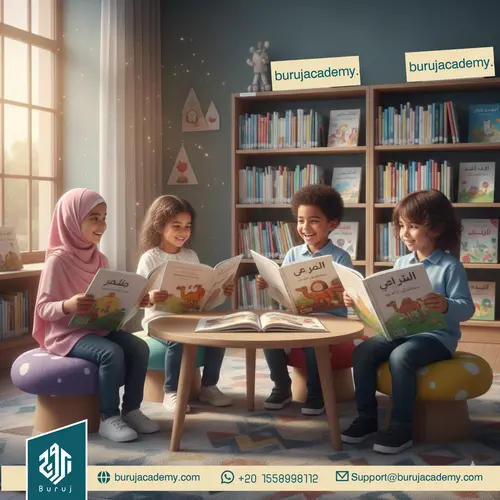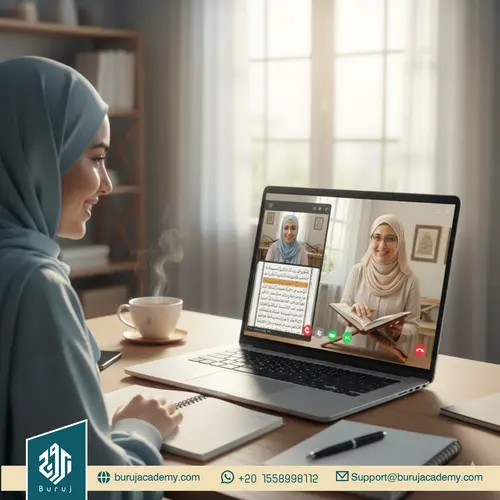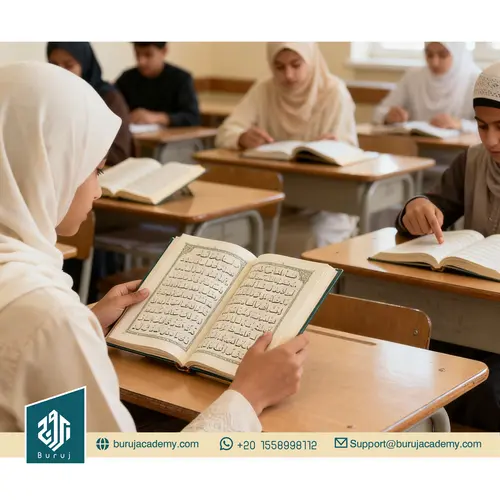How to Read Arabic for Kids: A Step-by-Step Guide for Understanding the Quran 📖
Why Learning Arabic Opens the Doors to the Quran
Learning to read Arabic is the essential first step toward a deeper connection with the Quran. For parents who want their children to not just recite the Holy Book but genuinely understand its message, starting with the language is crucial. The journey of how to read Arabic for kids focuses on more than just memorizing letters; it’s about building a foundation that interweaves language skills with religious understanding. At Buruj Academy, we recognize that this dual focus creates a more meaningful and enduring learning experience.
How to read Arabic for kids
This comprehensive guide outlines the best, most effective, and engaging steps to teach your child to read Arabic, specifically targeting the vocabulary and concepts necessary for Quranic literacy. We ensure our methods make learning both fun and profoundly rewarding.
Contact Us For More Details
Phase 1: Mastering the Arabic Alphabet (Al-Huruf Al-Hijaiyah)
The foundation of how to read Arabic for kids rests firmly on the 28 letters of the Arabic alphabet, known as Al-Huruf Al-Hijaiyah. This is where the learning journey begins.
Step 1: Learn the Letter Shapes and Names
Introduce the letters one by one. Do not rush this step. Arabic letters have distinct shapes and names, and understanding them is paramount.
- Focus on Visual Recognition: Use flashcards, block letters, or interactive apps to help your child associate the sound with the visual form. For example, introduce Alif (ا), Baa (ب), and Taa (ت) first.
- Active Recall: Ask your child to point to the letter when you say its name. We find that engaging games, like a “Letter Hunt,” make this process enjoyable.
- A Simple Start: Start by teaching the letters in their isolated form before moving to initial, medial, and final positions. This prevents early confusion.
Step 2: Grasping the Letter Sounds (Makharij al-Huruf)
Phonics is the single most important element in how to read Arabic for kids effectively for Quranic study. The correct articulation point (Makhraj) for each letter is critical for proper Tajweed later on.
- Practice Distinct Sounds: Emphasize the differences between light and heavy letters. For instance, contrast the light ‘S’ (س) with the heavy ‘Saad’ (ص). The difference is not just linguistic; it changes the meaning of words in the Quran.
- Use Auditory Aids: Play audio recordings of native Arabic speakers reciting the letters. Encourage your child to mimic the sound precisely. This ear training is invaluable.
- The Power of Repetition: Daily, short practice sessions focusing on 2-3 new letters at a time yield better results than long, infrequent sessions.
Phase 2: Understanding Vowel Marks and Diacritics (Harakat and Tanween) – How to read Arabic for kids
Once the alphabet is secure, the child must learn the Harakat (short vowels) and Tanween (nunation marks). These marks determine the pronunciation of a letter and are essential for fluently reading the Quran.
Step 3: Introduce the Short Vowels (Harakat)
The three primary short vowels dramatically change the letter’s sound. Teach them systematically:
- Fatha (3
): Makes an ‘a’ sound (like in “cat”). Show how
becomes
(ba).
- Damma (5
): Makes an ‘u’ sound (like in “put”). Show how
becomes
(bu).
- Kasra (7
): Makes an ‘i’ sound (like in “sit”). Show how
becomes
(bi).
- Create Syllables: Immediately combine letters with the Harakat to form simple, three-letter words or syllables, like
(kataba – he wrote). This moves the learning from abstract letters to functional reading units.
Step 4: Mastering the Shaddah, Sukun, and Madd
To complete the foundational mechanics of how to read Arabic for kids, introduce the other vital diacritics:
- Sukun: Indicates no vowel sound; the letter stops the sound, often forming a consonant blend (e.g.,
– an).
- Shaddah: The gemination or doubling mark. It tells the reader to pronounce the letter twice (e.g.,
– Rabb – Lord). This is crucial for Tajweed.
- Madd (Long Vowels): Introduce the three Madd letters (Alif, Waw, Yaa) that extend the sound of the short vowels. For example,
(baa – long a sound). These are common in the Quran and must be pronounced correctly.
Phase 3: Connecting Letters and Reading Simple Words
Arabic is a cursive language, meaning letters connect differently depending on their position. This is a major hurdle in how to read Arabic for kids, but with focused practice, they will overcome it.
Step 5: Understanding Connecting Forms
Show your child the four forms of each letter: isolated, initial, medial, and final.
- Visual Aids: Use a Noorani Qaida or similar structured textbook that clearly illustrates these forms. For example, show how Baa (
) changes in
(bait – house).
- Connecting Practice: Give your child exercises where they must connect separate letters to form a word. This active manipulation strengthens their understanding of the letter flow.
Step 6: Reading Basic Quranic Vocabulary – How to read Arabic for kids
Once the mechanics are solid, incorporate simple, high-frequency words found in the Quran. This step integrates the language and religious aims of the learning.
- Start with Common Terms: Introduce words like
(Allah),
(Rabb – Lord), (Naas – Mankind), and
(Kitab – Book).
- Build Confidence: Begin reading short verses from the last
of the Quran (e.g., Surah Al-Fatiha or Surah Al-Ikhlas). These are often short and repetitive, which boosts the child’s morale and sense of accomplishment.
Phase 4: Integrating Tajweed and Understanding Quranic Context
The ultimate goal of how to read Arabic for kids is not just pronunciation, but Tajweed (the art of proper recitation) and comprehension.
Step 7: Introducing Basic Tajweed Rules – How to read Arabic for kids
While advanced Tajweed comes later, children can begin with foundational rules early on.
- Focus on Noon Sakinah and Tanween: Teach the rules of Ikhfa (hiding the ‘n’ sound), Izhar (clear pronunciation), and Idgham (merging) through simple examples.
- Practical Application: Emphasize the importance of the Shaddah and Madd rules as they significantly impact the rhythm and meaning of the recitation.
Step 8: Combining Language and Religious Concepts
This is where the learning becomes meaningful. Tie the Arabic words the child reads to their Islamic context.
- Contextual Learning: When they read the word
(Salah – Prayer), discuss why Muslims pray and its significance. When they read
(Rasul – Messenger), talk about Prophet Muhammad (peace be upon him).
- Use Stories: Relate Quranic stories or basic
to the vocabulary they are learning. This makes the language feel alive and relevant to their faith.
The Buruj Academy Advantage: Structured Learning and Expert Tutors
The key to successfully teaching how to read Arabic for kids lies in consistency, structured curriculum, and the guidance of expert teachers.
At Buruj Academy, our dedicated and
courses are designed precisely for this journey. We employ interactive, engaging methodologies that keep children motivated. Our tutors specialize in children’s education, ensuring a patient and effective learning environment tailored to the unique needs of young learners. We offer personalized attention, recognizing that every child progresses at their own pace.
Why Choose Our Approach?
- Integrated Curriculum: We seamlessly blend Arabic language instruction with core Islamic studies, providing a holistic educational experience.
- Expert Tutors: Our experienced Arabic tutors are native speakers proficient in
and child psychology.
- Flexible Learning: We provide online classes that fit your family’s schedule, bringing quality education directly to your home.
Take the next step and explore our comprehensive Arabic Courses page for detailed information on enrollment and curriculum.
Conclusion: Starting the Lifelong Journey – How to read Arabic for kids
Learning how to read Arabic for kids is an investment in their faith and future. It equips them with the tools to unlock the true meaning of the Quran and fosters a deep, personal relationship with Islam. Remember to maintain a positive and encouraging environment, celebrating every milestone, no matter how small. With the right foundation and dedicated instruction, like that provided by your child will soon be reading the with confidence and comprehension.
Resources and Next Steps
For a personalized learning plan, visit our articles Learn Arabic alphabet for kids and Arabic Grammar for beginners
Explore the experts who will guide your child’s journey by reading this article Private online Arabic teacher
Follow Buruj Academy on Social Media:




